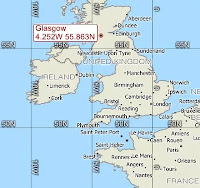 |
| Lat-long coordinates |
Schafer's lack of qualifications to write this content rear their ignorant head within the very first two sentences:
"Latitude and longitude coordinates are usually expressed as minutes per degree, and seconds. These coordinates can help locate any earthly destination within inches."
The weird notion of "any earthly destination" notwithstanding, Dana's words demonstrates poor grasp of the concept in two ways:
- We aren't certain what "expressed as minutes per degree" is supposed to mean, since there are always 60 minutes per degree. She probably meant "degrees, minutes, and seconds."
- A second of latitude equals about 101 feet, or 1,212 inches – so "within inches" would require that seconds be specified to two decimal places. For what it's worth, most professionals use decimal degrees out to five or six decimal places.
- Who said the coordinates are lat-long? They could easily be UTM or another projection.
Once she got the housekeeping out of the way, though, Dana lurched into two sets of instructions; although one is pretty much outdated and the other is... well, not very instructive.
Set one pertains to the use of MapQuest. Said instructions are, to be frank, useless because MapQuest's lat-long search no longer (if it ever did) requires the "latitude:" and "longitude:" keywords Schafer specified. Helpful hint? like Google Maps, MapQuest can locate a lat-long pair, if the numbers are entered properly. Type the pair as "latitude, comma, longitude" and follow the positive-negative convention of north and east are positive, west and south are negative. Google can also decipher 45N, 85W, but MapQuest apparently can't.
Set two pertains to using a GPS navigation unit. According to Dana, "GPS's [sic] have become useful for the everyday person..." Since Dana appeared utterly ignorant of GPSs, the instructions she pounded out pretty much boil down to,
RTFM.
Yeah: that's "How to Get Directions Using Coordinates" all right. Small wonder we've named Schafer our Dumbass of the Day.
SE - MAPS
No comments:
Post a Comment